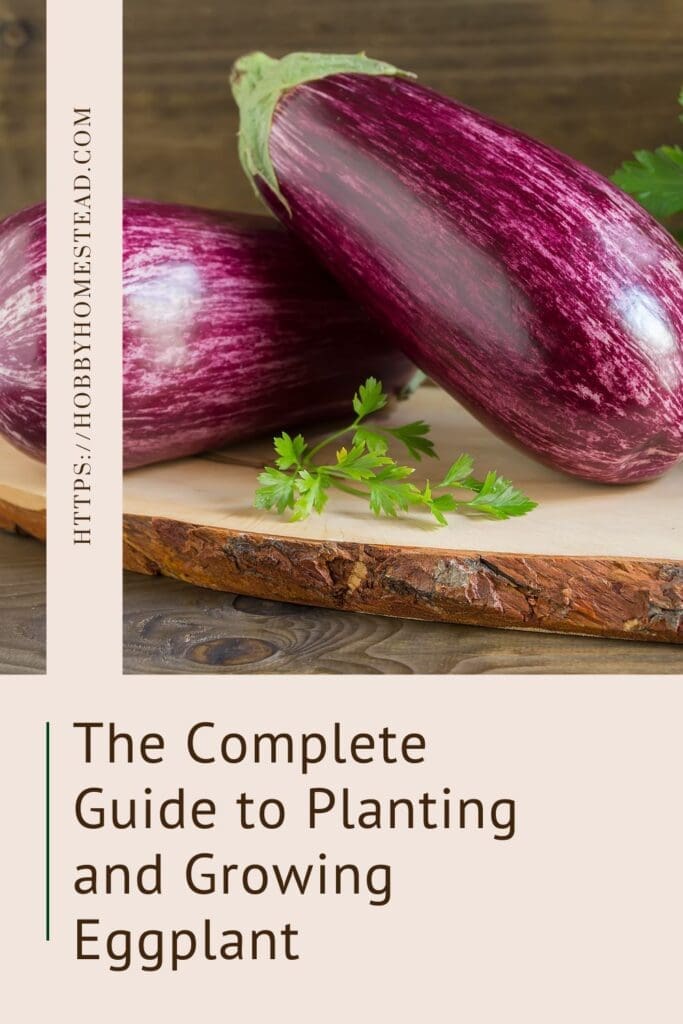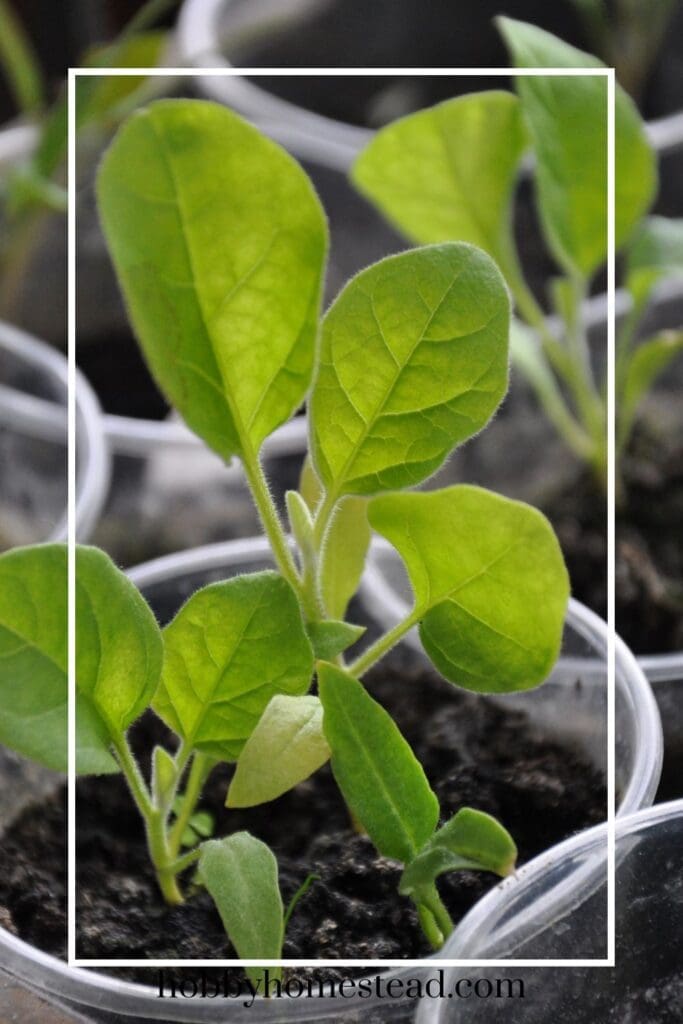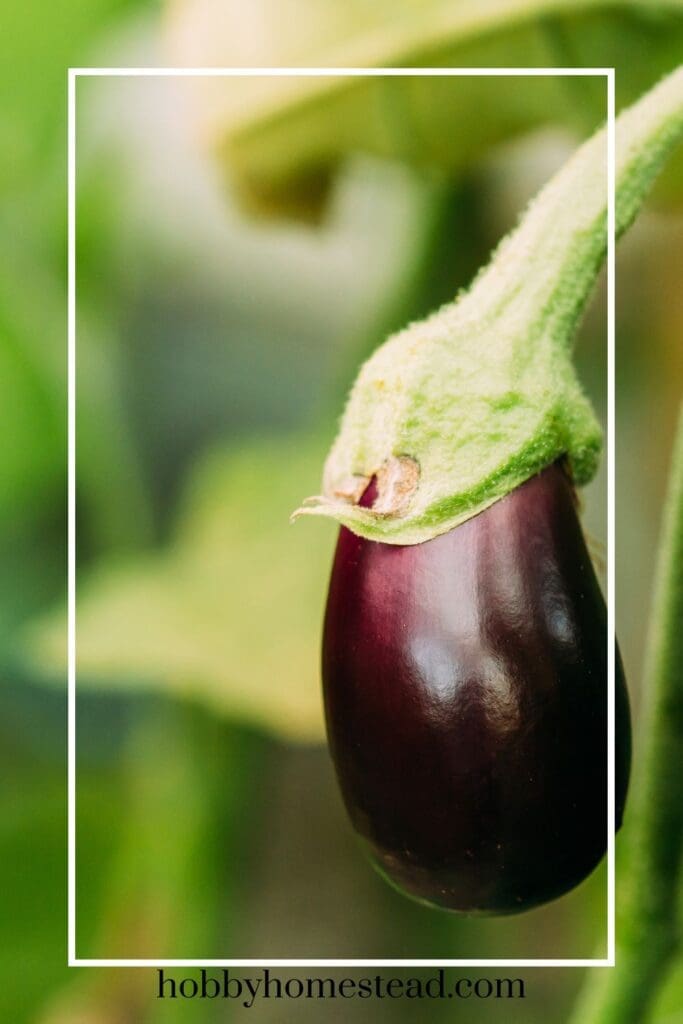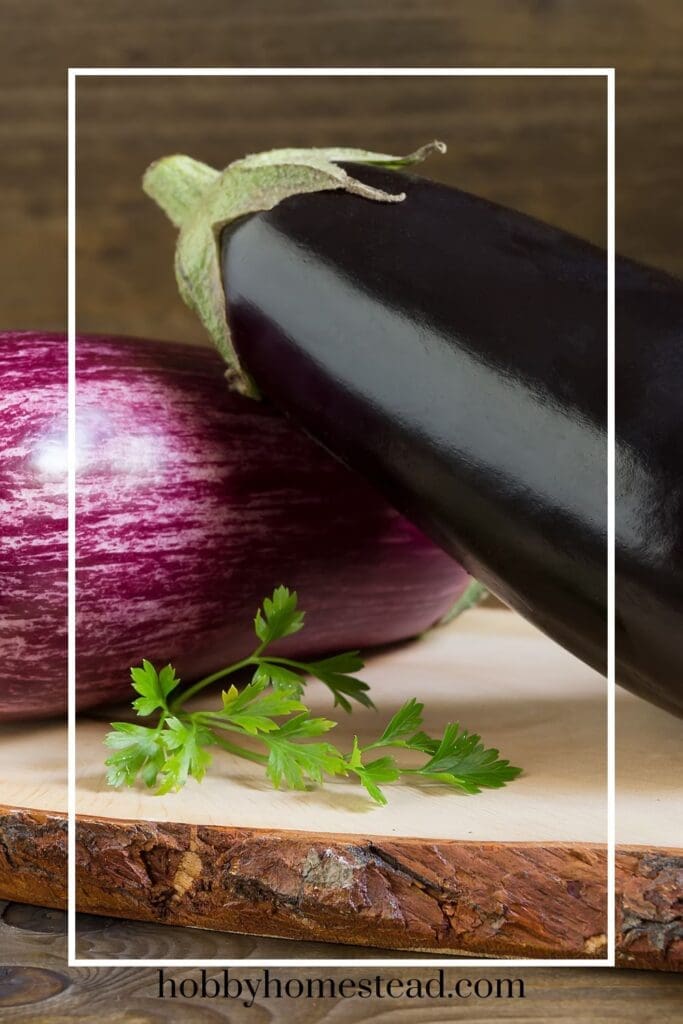Let’s talk about planting and growing eggplant today so you can have a bountiful harvest in the fall. If you’ve ever admired the glossy purple skin of a freshly picked eggplant, you’ll know there’s something deeply satisfying about growing your own.
Eggplants (also called aubergines) bring both beauty and bounty to the homestead garden. With their rich colors, unique shapes, and versatility in the kitchen, they’re a warm-season crop that rewards a little care with generous harvests.
Whether you’re a seasoned gardener or just starting your backyard or homestead garden, this complete guide to growing eggplant will walk you through everything. From choosing the right varieties to organic pest control and companion planting ideas.

About Eggplant
Eggplants belong to the nightshade family, alongside tomatoes, peppers, and potatoes. They thrive in warm weather and are prized for their mild, slightly earthy flavor and firm texture that works beautifully in dishes like ratatouille, grilled vegetables, or roasted eggplant parmesan.
While the classic deep purple globe variety is the most recognizable, eggplants come in many shapes, colors, and sizes. From long, slender Asian varieties to petite, striped heirlooms.
Best Eggplant Varieties to Grow
Here are some tried-and-true favorites for both home gardeners and small-scale homesteaders:
- Black Beauty. The traditional variety with large, glossy fruits and rich flavor.
- Ichiban (Japanese Eggplant). Long and slender with tender flesh; perfect for stir-fries and grilling.
- Fairy Tale. Small, striped, and fast-maturing—great for containers or smaller gardens.
- Rosa Bianca. Beautiful lavender and white fruit with a creamy texture; Italian heirloom variety.
- Patio Baby. Compact plants ideal for pots, raised beds, or limited spaces.
Understanding the Eggplant Growing Season
Eggplants are warm-season vegetables, which means they thrive in hot weather and can’t tolerate frost. They need a long growing season. Usually, 100 to 150 days from seed to harvest, depending on the variety and climate.
🌞 Temperature Requirements
- Warm soil and air are key. Eggplants prefer daytime temperatures between 75–90°F (24–32°C) and nighttime temperatures above 55°F (13°C).
- If temperatures dip too low, growth slows dramatically, and plants may drop blossoms or fail to set fruit.
🌱 Frost Sensitivity
- Eggplants are extremely frost-sensitive. Always plant them after the danger of frost has passed and soil has fully warmed.
- In cooler climates, start seeds indoors 8–10 weeks before your last expected frost date to get a head start.
- Use black plastic mulch or use row covers outdoors to warm the soil and protect young plants early in the season.
⏰ Length of Season
- Transplants usually take 65–80 days to mature after being moved outdoors.
- Short-season varieties like Patio Baby or Fairy Tale are an excellent choice if you live in northern regions or have a short summer.
- Gardeners in warmer southern climates can plant twice a year. Spring and midsummerfor extended harvests.
🪴 Quick Tip:
If your growing season is short, consider growing eggplant in containers so you can move them indoors during cold nights or start them early inside a greenhouse or sunny spot.
Ideal Growing Conditions
Eggplants are sun-loving plants that thrive in warm soil and full sun. They require at least 6–8 hours of sunlight daily.
Soil:
- Prefers well-drained soil. That is fertile with a pH between 6.0 and 6.8.
- Mix in compost or aged manure before planting to improve fertile soil structure and nutrients.
Temperature:
- Eggplants love heat! Ideal growing temperatures are 70–85°F (21–29°C).
- Avoid planting too early in the season. Wait until nighttime temperatures stay above 55°F (13°C).
Spacing:
- Space plants 18–24 inches apart in rows about 2–3 feet apart to allow airflow and reduce disease.

How to Plant Eggplant
Starting from Seeds:
- Start seeds 8–10 weeks before the last expected frost indoors.
- Keep seedlings warm (around 75–85°F) using a seed heating mat if needed.
- Transplant seedlings outdoors once they’re 6–8 inches tall and hardened off.
Transplanting:
- Plant seedlings deeply, burying part of the stem to encourage strong root growth.
- Mulch around the base with straw or shredded leaves to retain moisture and suppress weeds.
Starting Eggplant Seeds: A Step-By-Step Guide
Starting eggplants from seed gives you more different varieties than transplanting from a nursery, and it allows you to get a head start on the growing season. Because eggplants need warmth to thrive. For best results, starting them indoors is essential, especially in cooler climates.
1. Timing
- Start seeds 8–10 weeks before the last expected frost date in your area.
- Keep in mind that eggplants are slow growers early on; they often need 2–3 months to reach transplant size.
2. Choosing Containers
- Use peat pots, seed trays, or small biodegradable pots. Peat pots are great because you can plant them directly in the soil without disturbing the roots.
- If using regular seed trays or pots, make sure they have drainage holes to prevent waterlogging.
3. Soil Mix
- Fill pots with a light, well-draining seed-starting mix with healthy organic matter. Avoid heavy garden soil, which can compact and suffocate seedlings.
- You can mix in a small amount of perlite or vermiculite to improve drainage and aeration.
4. Sowing Seeds
- Sow seeds about ¼ inch deep and cover lightly with soil.
- Keep the soil evenly moist, not soggy. A spray bottle works well for gentle watering.
5. Temperature & Light
- Eggplant seeds germinate best at 75–85°F (24–29°C).
- Using a seed heating mat can help maintain consistent warmth.
- Once seedlings emerge, provide 12–16 hours of bright light daily using grow lights or a sunny south-facing window. Rotate seedlings occasionally for even growth.
6. Thinning & Transplanting
- Once seedlings develop sets of leaves, 2–4 true leaves at the base of the plant. Thin them if needed so only the strongest remain.
- Harden off seedlings 1–2 weeks before transplanting outdoors: gradually expose them to outdoor conditions. Starting with a few hours of morning sun and slowly increasing exposure. This helps ensure that you have healthy plants and gives them a good start.
7. Fertilizing Seedlings
- Once seedlings have their first set of true leaves, you can feed them with a diluted organic liquid fertilizer to encourage strong, healthy growth.
🪴 Quick Tip:
- Peat pots are convenient, but if you’re concerned about sustainability, try biodegradable pots made of coir, paper, or recycled materials. They break down in the soil and reduce transplant shock.
- Avoid letting seedlings get leggy by providing enough light and keeping them moderately warm, not too hot.

How to Grow Eggplant in Containers
If you don’t have a large garden space or just want to keep your eggplants close to the kitchen, container growing is an easy and productive option. Eggplants adapt beautifully to pots as long as they have plenty of sunlight, warmth, and rich soil.
🌞 Choose the Right Container
- Select a container at least 14–16 inches in diameter and 12–14 inches deep for each plant.
- Larger is better. Eggplants have deep roots and appreciate extra space.
- Use containers with good drainage holes to prevent soggy roots.
- Terracotta pots help keep roots warm, while fabric grow bags allow excellent air circulation and root development.
🌱 Potting Mix
- Use a high-quality potting mix rather than garden soil, which can be too heavy for containers.
- Mix in compost or aged manure before planting for slow-release nutrients.
- For extra drainage, add a small amount of perlite or coarse sand.
☀️ Light and Location
- Place containers in a full-sun location, where plants will get at least 6–8 hours of direct sunlight daily.
- If temperatures drop below 55°F at night, move pots to a sheltered spot or cover them to retain warmth.
💧 Watering
- Container-grown eggplants dry out faster than those in the ground.
- Water deeply whenever the top inch of soil feels dry. Usually once a day in hot weather.
- To prevent blossom drop, keep soil consistently moist but not waterlogged.
🌿 Feeding
- Feed plants every 2–3 weeks with an organic liquid fertilizer or compost tea once flowering begins.
- A slow-release organic fertilizer can also be mixed into the soil at planting time.
🪴 Supporting the Plants
Even smaller varieties can become top-heavy as they fruit.
- Add a tomato cage, stake, or trellis at planting time to keep branches upright and prevent breakage.
- Support helps improve airflow and keeps fruit clean and off the soil surface.
🍆 Best Varieties for Containers
Compact varieties do especially well in pots. Try these options for high yields in small spaces:
- Patio Baby. Dwarf plant that produces early, tender fruits.
- Fairy Tale. Beautiful striped, small eggplants with creamy flesh.
- Ichiban (Japanese). Slender fruits and prolific production.
- Hansel and Gretel. Mini white and purple varieties perfect for containers.
💡 Quick Tip:
If your growing season is short, containers can give you a head start. Simply start the plants indoors, then move them outside when the weather warms. You can also bring them into a greenhouse or sunny porch in the fall to extend harvest time.
Watering, Feeding, and Care
- Keep soil consistently moist but not soggy. Water at the base to avoid wetting the leaves.
- A layer of organic mulch helps maintain even soil temperature and moisture.
- Feed every few weeks with a balanced organic fertilizer or compost tea once the plants start setting fruit.
Tip: Avoid high-nitrogen fertilizers, which can lead to lush foliage but fewer fruits.
Organic Gardening Tips
- Rotate crops each year. Don’t plant eggplant where tomatoes, peppers, or potatoes grew last season.
- Encourage beneficial insects like ladybugs and lacewings by planting flowers such as marigolds and alyssum nearby.
- Use neem oil or insecticidal soap for pest control instead of harsh chemicals.
- Companion planting (see below!) can help naturally deter pests and promote better growth.

Companion Planting Ideas
Eggplant pairs beautifully with several other garden plants:
🌿 Best Companions:
- Basil. Enhances growth and flavor while repelling aphids and spider mites.
- Peppers. Share similar growing needs and help maximize garden space.
- Beans. Add nitrogen to the soil naturally, helping your eggplants thrive.
- Spinach and Lettuce. Low-growing companions that provide natural ground cover.
- Marigolds. Repel harmful nematodes and attract pollinators.
🚫 Avoid Planting Near:
- Fennel. It inhibits the growth of many vegetables.
- Potatoes. Can spread soil-borne diseases that affect eggplant.
Common Pests and Problems
Like other members of the nightshade family, eggplants are prone to a few garden challenges.
- Flea Beetles. Tiny holes in leaves. Cover plants with row covers or dust lightly with diatomaceous earth.
- Aphids. Spray with a strong jet of water or use neem oil.
- Blossom Drop. Caused by high heat or inconsistent watering; keep soil moisture steady.
- Verticillium Wilt. Prevent by rotating crops and avoiding planting in the same spot year after year.
How to Control Pests Naturally
Eggplants are hardy once established, but a few pests can make them look less than perfect. Fortunately, there are many organic ways to protect your plants and keep them thriving all season long.
🪲 1. Flea Beetles
These tiny, black jumping beetles leave small “shot holes” in leaves and can quickly damage young plants.
Control Tips:
- Use floating row covers to protect eggplant seedlings until they’re strong enough to withstand some feeding.
- Dust the soil around the plants with diatomaceous earth, an organic powder that discourages crawling insects.
- Encourage natural predators like ladybugs and lacewings by planting dill, fennel, and alyssum nearby.
- Keep the area weed-free since flea beetles like to hide in nearby weeds.
🐞 2. Aphids
These soft-bodied pests cluster on stems and undersides of leaves, sucking plant juices and spreading disease.
Control Tips:
- Spray plants with a strong stream of water to knock off aphids.
- Apply neem oil or insecticidal soap weekly until the population is under control.
- Introduce or attract beneficial insects such as ladybugs and hoverflies that naturally prey on aphids.
- Avoid over-fertilizing with nitrogen. Lush new growth attracts aphids.
🐛 3. Colorado Potato Beetles
These striped beetles (and their red larvae) can chew through leaves rapidly.
Control Tips:
- Handpick and destroy eggs, larvae, and adults. Check the undersides of leaves daily.
- Rotate crops each year to prevent overwintering beetles from finding new host plants.
- Use a thick mulch layer to disrupt the beetles’ life cycle.
- For heavy infestations, use an organic biological control like Bacillus thuringiensis (Bt), safe for humans and pollinators.
🐜 4. Spider Mites
These tiny pests cause yellow stippling on leaves, especially in hot, dry weather.
Control Tips:
- Spray leaves with water mist regularly to increase humidity.
- Introduce predatory mites or ladybugs.
- Apply horticultural oil or neem oil to suffocate mites.
🌱 5. Cutworms
They chew through young stems near the soil line, often overnight.
Control Tips:
- Place cardboard collars around seedlings when transplanting.
- Clear plant debris to reduce hiding spots.
- Sprinkle crushed eggshells or coffee grounds around stems to deter them.
💚 Homestead Tip: Healthy soil produces resilient plants. Regularly adding compost and rotating crops makes your garden less inviting to pests and reduces disease pressure naturally.
How to Tell When Eggplant Is Ripe
Knowing when to harvest eggplant is key to getting the best flavor and texture. Pick too soon, and the eggplant fruit will be small and bitter. Wait too long, and it becomes seedy and tough.
Here’s what to look for:
- Glossy Skin:
The fruit should have a rich, shiny appearance. Once the skin begins to look dull or faded, it’s past peak ripeness. - Firmness Test:
Gently press the skin with your thumb.- If it leaves a slight indentation that bounces back quickly, it’s ready to harvest.
- If it feels hard and doesn’t give, it’s underripe.
- If the indentation stays, it’s overripe.
- Size and Variety:
Each variety matures at a different size:- Black Beauty: 6–8 inches long
- Ichiban (Japanese): 8–10 inches long and slender
- Fairy Tale: 4–5 inches long
Always check the seed packet or tag for the expected mature size of your chosen variety.
- Seeds:
When cut open, ripe eggplants have soft, pale seeds. If the seeds are dark or hard, the fruit is overripe. - Frequent Picking Encourages More Fruit:
Harvesting regularly signals the plant to produce more. Don’t let fruits linger too long. Eggplants grow best when harvested every few days once they start producing.
🪴 Quick Tip: Always use garden shears or a sharp knife to cut the fruit with a short stem attached. Pulling it by hand can damage the plant.
Harvesting and Storage Tips
You can begin harvesting when fruits are glossy and firm but before the skin dulls.
- Use pruning shears or a sharp knife to cut fruit with a bit of stem attached.
- Avoid pulling them off by hand to prevent damage to the plant.
- Store freshly picked eggplant in a cool, dry place and use within a week for the best flavor and texture.
For longer storage, slice and freeze or roast before preserving.
How to Use Eggplant in the Kitchen
Eggplant’s versatility makes it a staple in kitchens worldwide. Grill it, roast it, or add it to stews and casseroles. Sneak it into your favorite dishes. Some favorite ways to use your harvest include:
- Grilled eggplant slices brushed with olive oil and herbs.
- Homemade eggplant parmesan.
- Roasted eggplant dip (baba ganoush).
- Sautéed with tomatoes, onions, and garlic for a simple side dish.
Final Thoughts
Growing eggplant is both rewarding and beautiful. Perfect for any homestead or backyard garden. Once you understand their warm-weather needs and give them a little organic care, they’ll reward you with glossy, flavorful fruits all season long.
You’ll have a bountiful crop for all your favorite eggplant dishes. Eggplants bring color, variety, and delicious possibilities to your table.
References
Bonnie Plants. How to Grow and Plant Eggplant.
University of Minnesota Extension. Growing Eggplant in Home Gardens


